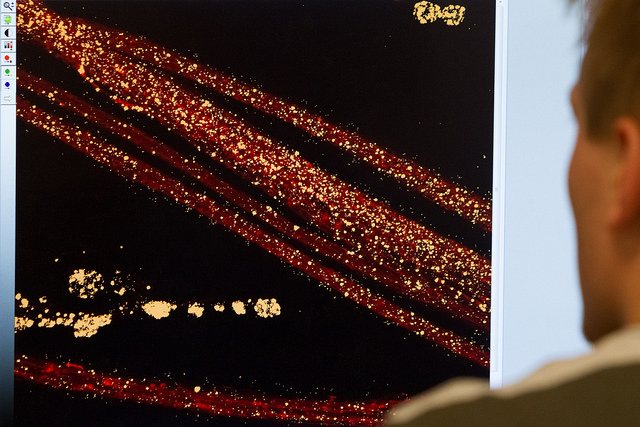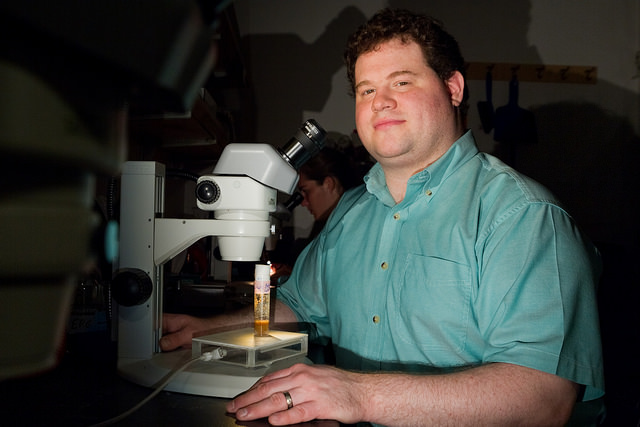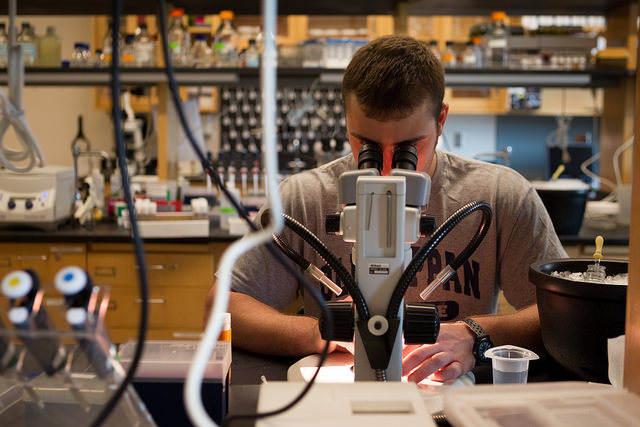Here’s a humbling notion: the nervous system of a fruit fly larva and that of a human are remarkably similar.
Ethan Graf, assistant professor of biology at Amherst College, calls this similarity “evolutionary conservation,” and he’s been making full use of it since 2005. That’s when he first began studying the synapses, or connections, between neurons in the brain and nervous system of Drosophila melanogaster, the common fruit fly.

Brain circuitry at the cellular level
It’s research that has implications for better understanding and potentially treating degenerative and developmental neurological disorders such as Alzheimer’s and autism.
And it’s research that has netted Graf a three-year, $371,823 grant from the National Institutes of Health. The NIH recently announced its support for a Brain Research through Advancing Innovative Neurotechnologies (BRAIN) Initiative that would dramatically increase funding for brain research over the next 12 years.

Graf in his McGuire Life Sciences Building laboratory
Graf’s research is focused on understanding how synapses in the brain work, and how they develop and change over time.
“What makes the brain very interesting is that throughout our lives we form new synapses and destroy old synapses,” Graf said. “We also strengthen and weaken synapses, and this changes the brain’s circuitry, which is responsible for such things as learning and memory. I research how synapses form and how they can change, and I do this with fruit flies.”
Specifically, Graf is studying the synapses between neurons and muscles that, when activated, cause muscles to contract. Working with three Amherst students and a recent graduate this summer (Charles Reighard '14, Pete Alsharif '15, Alissa Rothman '15 and Topher Flanagan '16), he does research that involves disrupting or altering the expression of proteins and genes associated with synapse development. These proteins and genes are remarkably similar across species.

Pete Alsharif '15 in Ethan Graf's lab
“Synapses in fruit flies function in the same way and have the same proteins as synapses in our brain, but they’re easier to study,” Graf said. “My research doesn’t involve human subjects, or any vertebrates for that matter, and we can manipulate the genetics of the fruit flies very easily.”
Graf said that after almost 14 years of studying synapse development—first at Washington University, where he received his Ph.D. and was a postdoctoral fellow, and now at Amherst—he’s still excited by his work.
“I think the fun part about this research is how unexpected the findings can be,” he said. “Even after studying a system or a gene that has been worked on for 25 years, we’re still finding brand-new things about it. The most exciting moments I’ve had as a scientist have been when I’ve landed on an unexpected finding that no one has ever seen before and no one has ever thought to look at before.”